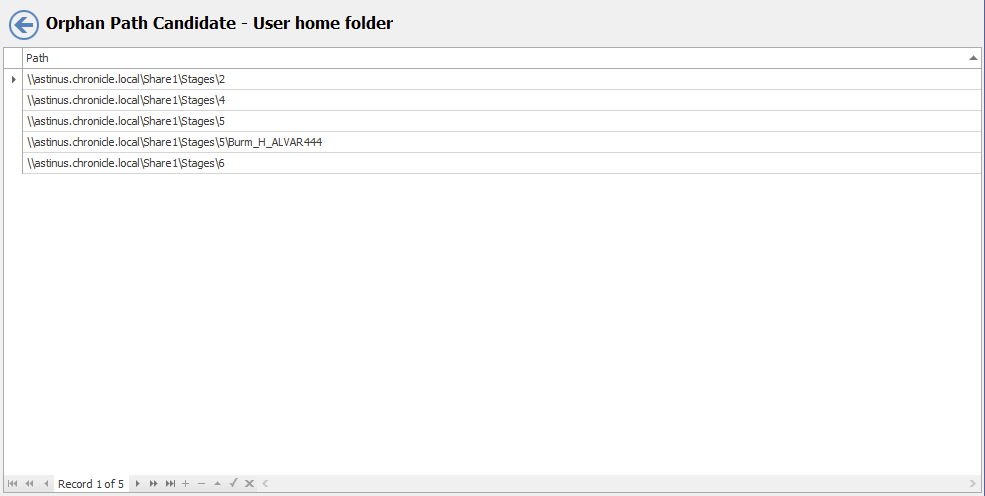C.4 GSR Collector Anomaly Analysis
The GSR Collector performs Anomaly Analysis that generates data for Anomaly Reports. These reports are designed to help you evaluate the state of your storage infrastructure. Additionally, they can be used in preparation for using Novell Storage Manager to bring storage under management by policy. Anomaly data will be produced for each object and path type specified in the GSR Collector configuration.
Figure C-4 Anomaly Analysis
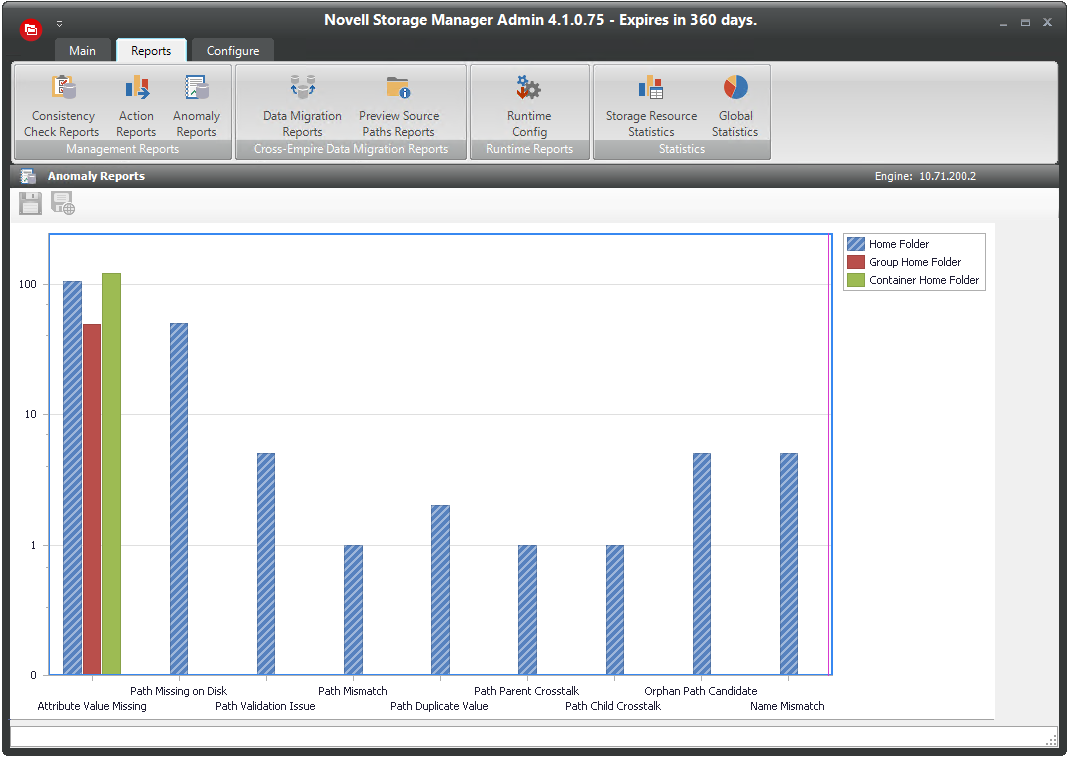
C.4.1 Attribute Value Missing
This anomaly report indicates that the respective path attribute (e.g. home folder) does not have a value for a given object in Active Directory.
A sample Attribute Value Missing anomaly report is shown below. The Object FDN and Object SAM Account Name columns display the respective attributes. The Managed Path column does not have a value because this object is not yet managed by Novell Storage Manager. These objects are reported because they do not have homeDirectory attribute values. This report can be used to identify objects that should be managed. It can also identify objects that have had their respective path attribute cleared accidentally or erroneously by an identity management system.
Figure C-5 Attribute Value Missing Anomaly Report

C.4.2 Path Missing on Disk
This anomaly report indicates that the respective path attribute value (e.g. home folder) for a given object cannot be found on disk.
A sample Path Missing on Disk anomaly report is shown below. The Object FDN and Object SAM Account Name columns display the respective attributes. The Path column is the value of the homeDirectory attribute. The Managed Path column does not have a value because this object is not yet managed by Novell Storage Manager. This object is reported because the path specified by its homeDirectory attribute does not exist on disk or could not be found. This report can be used to identify objects whose respective path attribute value no longer exists at that location because of accidental deletion or being moved manually.
Figure C-6 Path Missing on Disk Anomaly Report
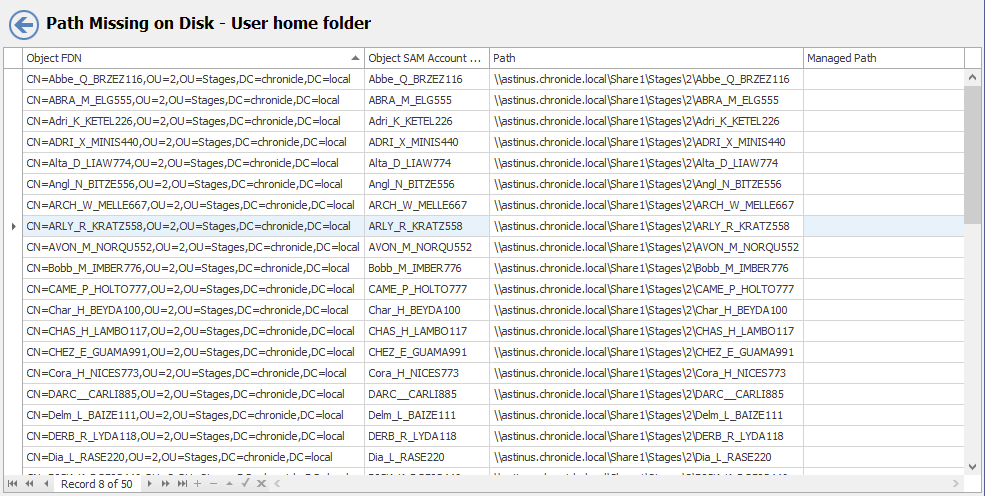
C.4.3 Path Validation Issue
This anomaly report indicates that there were errors when attempting to retrieve or verify the existence of the respective path attribute value (e.g. home folder).
A sample Path Validation Issue anomaly report is shown below. The Object FDN and Object SAM Account Name columns display the respective attributes. The Path column is the value of the homeDirectory attribute. The Managed Path column does not have a value because this object is not yet managed by Novell Storage Manager. These objects are reported because there was an error when trying to verify the existence of the path specified by their homeDirectory attribute.
This report can be used to identify objects whose respective path attribute value no longer exists at the specified location or if the NSM Engine has an issue communicating with the server or share on which the path is located. The symptoms can be:
-
The share no longer exists
-
The server is down or no longer in commission
-
A permissions issue keeps us from asking for the path
-
Some other connectivity issue exists
Figure C-7 Path Validation Issue Anomaly Report
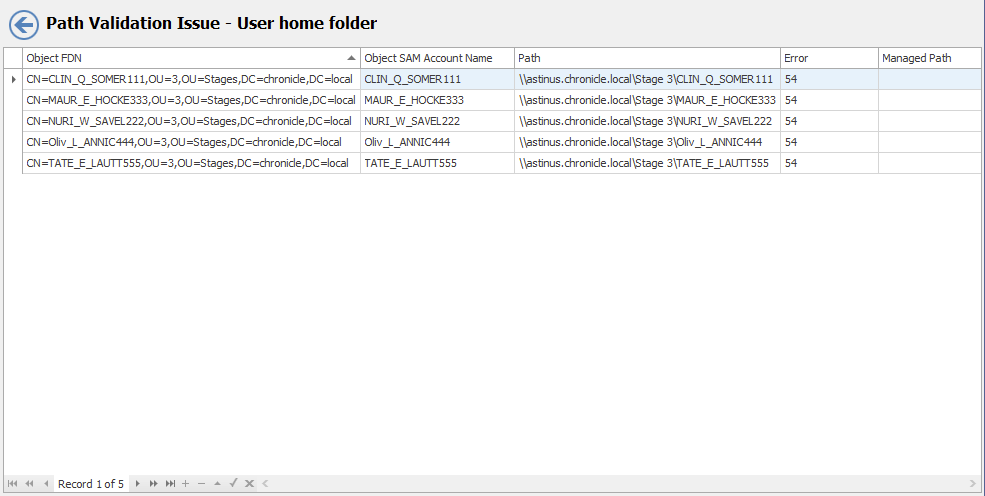
C.4.4 Name Mismatch
This anomaly report indicates that the leaf path name of the respective attribute value (e.g. home folder) does not match that of the respective object’s name.
A sample Name Mismatch anomaly report is shown below. The Object FDN and Object SAM Account Name columns display the respective attributes. The Path column is the value of the homeDirectory attribute. The Path column contains the current respective path attribute value obtained from Active Directory. The Managed Path column contains the path value when the object was last managed. This object is reported because the leaf path name specified by its homeDirectory attribute does not match the sAMAccount name attribute. This report can be used to identify objects whose respective path might have been changed manually.
Figure C-8 Name Mismatch Anomaly Report
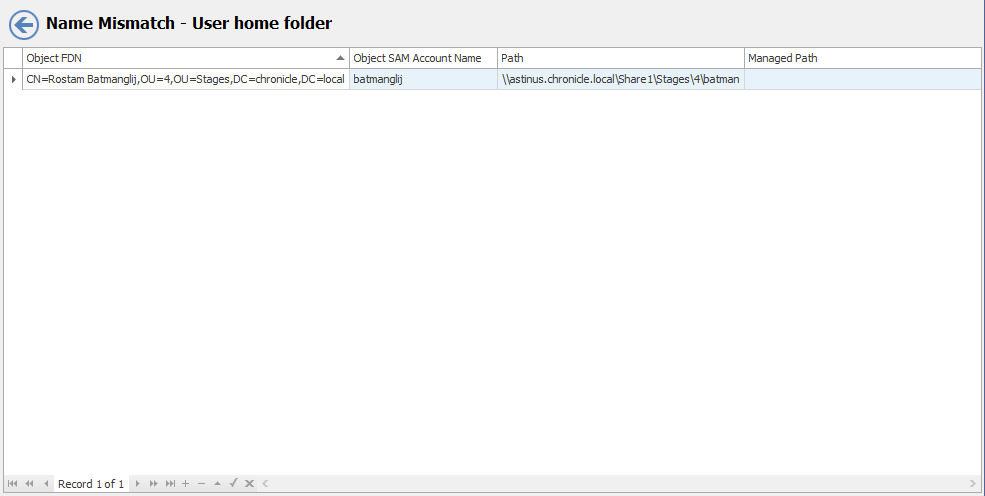
C.4.5 Path Mismatch
This anomaly report indicates that the respective path attribute value (e.g. home folder) does not match the last known managed path database entry.
A sample Path Mismatch anomaly report is shown below. The Object FDN and Object SAM Account Name columns display the respective attributes. The Path column is the value of the homeDirectory attribute. The Path column contains the current respective path attribute value obtained from Active Directory. The Managed Path column contains the path value when the object was last managed. This object is reported because the path specified by its homeDirectory attribute does not match the managed path value. This report can be used to identify objects whose respective path might have been changed manually.
Figure C-9 Path Mismatch Anomaly Report
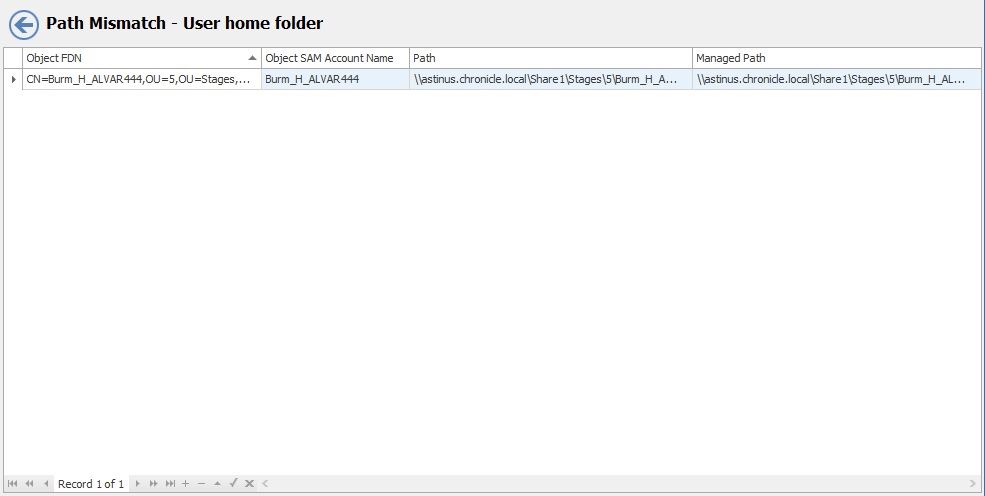
C.4.6 Path Duplicate Value
This anomaly report indicates that two or more objects have been detected that contain the same value for the respective path attribute (e.g. home folder).
A sample Path Duplicate Value anomaly report is shown below. The Object FDN and Object SAM Account Name columns display the respective attributes. The Path column is the value of the homeDirectory attribute. The Path column contains the current respective path attribute value obtained from Active Directory. The Managed Path column does not have a value because these objects are not yet managed by Novell Storage Manager. These objects are reported because they have the same value for their homeDirectory attribute. This report can be used to identify objects who erroneously share the same path for the respective path attribute.
Figure C-10 Path Duplicate Value Anomaly Report
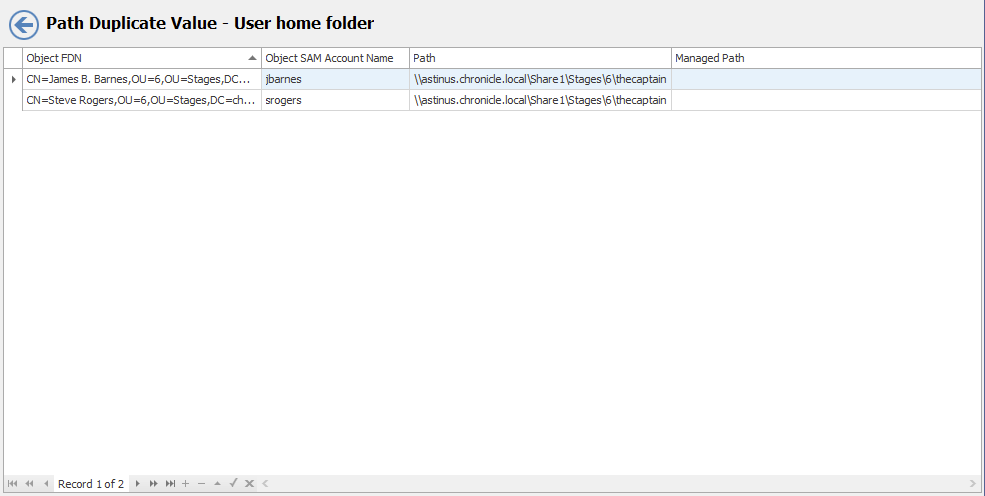
C.4.7 Path Parent CrossTalk
This anomaly report indicates that the object’s respective path attribute value (e.g. home folder) has been detected as being the parent of another object’s path attribute value (e.g. home folder).
A sample Path Parent Crosstalk anomaly report is shown below. The Object FDN and Object SAM Account Name columns display the respective attributes. The Path column is the value of the homeDirectory attribute. The Path column contains the current respective path attribute value obtained from Active Directory. The Managed Path column does not have a value because these objects are not yet managed by Novell Storage Manager. This object is reported because the value for its homeDirectory attribute has been detected as being the parent of another object’s homeDirectory attribute. This report can be used to identify objects whose respective path attribute is set to the wrong location and might impact another object’s storage.
Figure C-11 Path Parent CrossTalk Anomaly Report
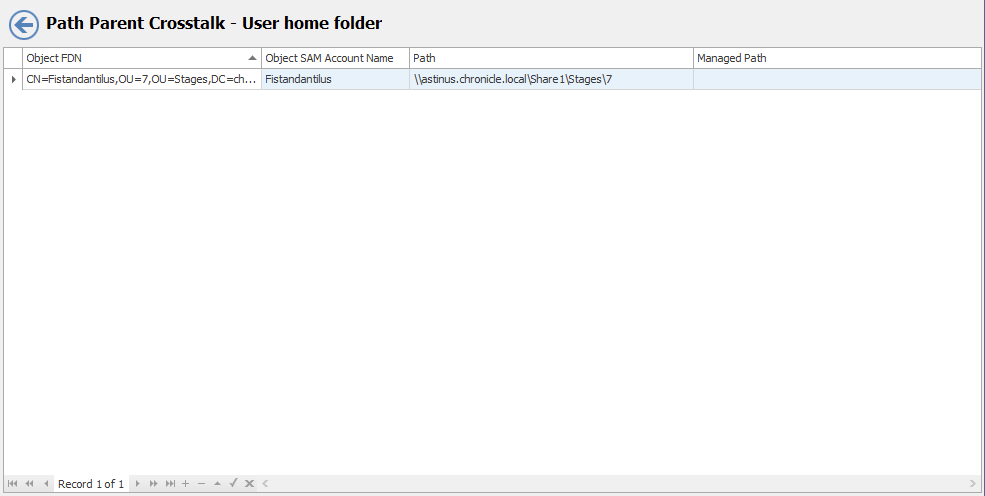
C.4.8 Path Child CrossTalk
This anomaly report indicates that the object’s respective path attribute value (e.g. home folder) has been detected as being the subordinate of another object’s path attribute value (e.g. home folder).
A sample Path Child Crosstalk anomaly report. The Object FDN and Object SAM Account Name columns display the respective attributes. The Path column is the value of the homeDirectory attribute. The Path column contains the current respective path attribute value obtained from Active Directory. The Managed Path column does not have a value because these objects are not yet managed by Novell Storage Manager. This object is reported because the value for its homeDirectory attribute has been detected as being the child of another object’s homeDirectory attribute. This report can be used to identify objects whose respective path attribute might be impacted by another object’s storage.
Figure C-12 Path Child CrossTalk Anomaly Report
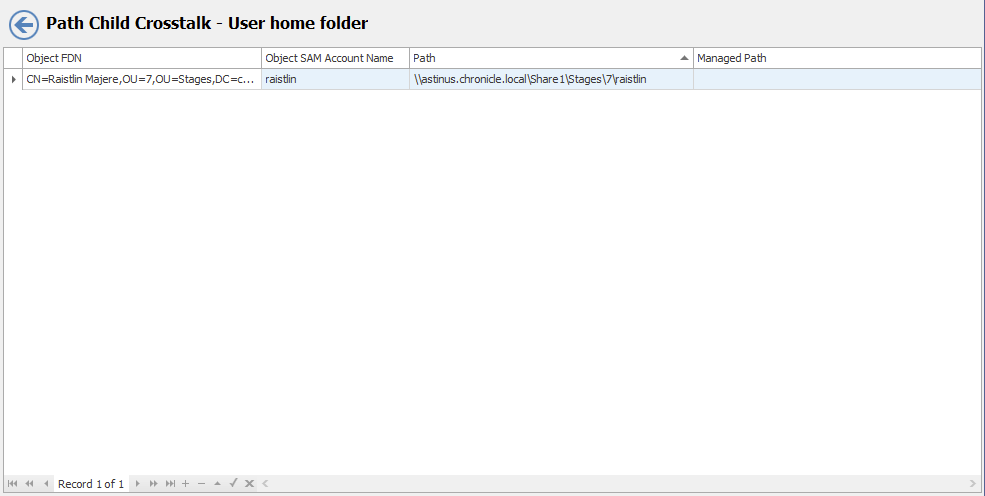
C.4.9 Orphan Path Candidate
This anomaly report indicates that the path is directly subordinate to a path at which other DS-associated paths have been found, but has not been detected as being associated with any DS object via a path attribute (e.g. home folder).
A sample Orphan Candidate anomaly report is shown below. The Path column is any path that is directly subordinate to a path at which other DS-associated paths have been found. However, the path is not associated with any object via a path attribute. This report can be used to identify folders that don’t belong to objects or are considered unmanaged.
Figure C-13 Orphan Path Candidate Anomaly Report
